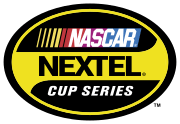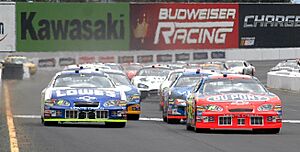NASCAR Cup Series facts for kids
 |
|
| Category | Stock cars |
|---|---|
| Country | United States |
| Inaugural season | 1949 |
| Manufacturers | Chevrolet · Ford · Toyota |
| Engine suppliers | Chevrolet · Ford · Toyota |
| Tire suppliers | Goodyear |
| Drivers' champion | Kyle Larson |
| Makes' champion | Chevrolet |
| Teams' champion | Hendrick Motorsports |
The NASCAR Cup Series is the top level of stock car racing in the United States. It's where the fastest and most famous stock car drivers compete, organized by the National Association for Stock Car Auto Racing.
This exciting racing series started way back in 1949. Over the years, it has had different names because of various sponsors. It was known as the "Strictly Stock Division" and then the "Grand National Division." Later, it became the "NASCAR Winston Cup Series," then the "NASCAR Nextel Cup Series," the "NASCAR Sprint Cup Series," and the "Monster Energy NASCAR Cup Series." Since 2020, it's simply called the NASCAR Cup Series, with several "Premier Partners" like Busch Beer, Coca-Cola, and Xfinity. Freeway Insurance is scheduled to join as a premier partner in 2026.
Drivers earn points based on how they finish in each race and how many laps they lead. The season has a special playoff system called the NASCAR playoffs. After 26 races, the top drivers compete in the final ten races to decide the champion.
Many races are held in the Southeastern United States, but the series also visits tracks all over the country. Some special races have even happened in other countries like Japan and Canada! The Daytona 500 is the most famous race of the year.
Cup Series cars are super powerful, reaching speeds over 200 miles per hour (320 km/h)! They are built to strict rules to make sure the competition is fair and exciting.
Contents
History of NASCAR Cup Racing
Early Days: Strictly Stock and Grand National
In 1949, NASCAR started the "Strictly Stock" division. These early races were held on dirt ovals and even on the Daytona Beach beach/street course.
The very first NASCAR "Strictly Stock" race was on June 19, 1949, at Charlotte Speedway. Jim Roper was the winner, and Red Byron became the first series champion. For the 1950 season, the division was renamed "Grand National." This name showed NASCAR's goal to make the sport more professional. Martinsville Speedway is the only track from that 1949 schedule still used today.
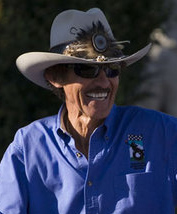
In the early years, the Grand National schedule sometimes had over sixty events! Often, there were two or three races on the same weekend. Most races were on dirt tracks. Darlington Raceway, opened in 1950, was the first fully paved track over 1 mile (1.6 km) long. By the 1960s, more superspeedways were built, and dirt tracks were paved. The last Grand National race on a dirt track (until 2021) was in 1970.
The Winston Cup Era
Between 1971 and 2003, a company named Winston sponsored NASCAR's top series, so it was called the Winston Cup Series. This sponsorship helped the sport grow a lot! The name changed because new rules about advertising meant companies had to find different ways to promote themselves.
This era is often called NASCAR's "modern era" because of many changes. The season became shorter, and the points system was updated. Races on dirt tracks and very short oval tracks were removed from the main schedule. Bill France Sr., NASCAR's founder, passed control to his son, Bill France Jr.. In 1974, a new points system was created where all races gave equal points. This made sure top drivers had to compete in every race to win the championship.
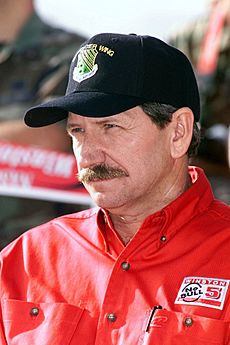
Since 1982, the Daytona 500 has been the first big race of the year. In 1979, the Daytona 500 was the first stock car race shown live on national television from start to finish. During the last lap, Cale Yarborough and Donnie Allison crashed while fighting for the lead. This allowed Richard Petty to win! After the crash, Yarborough, Allison, and Donnie's brother Bobby got into a fight on TV. This exciting moment showed the drama of the sport and helped it become more popular.
In 1985, Winston started the "Winston Million" award. A driver who won three of the four most important races would get one million dollars. Only Bill Elliott (1985) and Jeff Gordon (1997) won this big prize.
The series became very popular in the 1990s. In 1994, NASCAR held the first Brickyard 400 at Indianapolis Motor Speedway. This growth happened as other types of American car racing became less popular. In 2001, the creators of the animated film Cars visited NASCAR tracks for research. The movie's "Piston Cup" was inspired by the Winston Cup.
Nextel and Sprint Cup Eras
In 2002, Winston announced they would end their sponsorship. NASCAR then made a deal with Nextel, a phone company. So, in 2004, the series became the Nextel Cup Series.
When Sprint and Nextel merged in 2006, the Cup Series was renamed the Sprint Cup Series starting in 2008. The Sprint Cup trophy was designed by Tiffany & Co. and was made of silver.
By 2009, the sport's popularity had settled down after a big growth in the 1990s. Some fans felt the series was changing too much, especially with new tracks and different car manufacturers joining. To keep the sport exciting and fair, NASCAR made some important changes. In 2016, they introduced a 'charter system' to guarantee 36 teams a spot in all 36 races, and they also set the race field size to 40 cars.
The Chase for the Cup (NASCAR Playoffs)
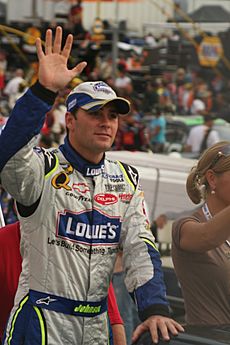
In 2004, a new system was introduced to decide the series champion, called the Chase for the Nextel Cup (or "The Chase"). This system was like a playoff.
Here's how it works:
- After the first 26 races, the top drivers (usually 16) who have won races or earned the most points qualify for the Chase.
- Their points are reset, and they get bonus points for their wins.
- The Chase is divided into four rounds. After each of the first three rounds, some drivers are eliminated based on their points.
- Any driver who wins a race in the first three rounds automatically moves on to the next round.
- The final round, called the "Championship 4," has four drivers competing in the last race of the season. The driver who finishes highest among these four in that final race wins the Cup Series title!
This playoff system was created to make the championship race more exciting until the very end of the season. Before, the champion could sometimes be known several races before the season finished.
Monster Energy NASCAR Cup Series
After the Sprint sponsorship ended in 2016, Monster Energy became the new sponsor. The series was renamed the Monster Energy NASCAR Cup Series from 2017 to 2019.
In 2017, "stage racing" was introduced. Races were split into stages. At the end of the first two stages, the top 10 drivers earned extra championship points. The winner of a stage also got a bonus point for the playoffs. This made every part of the race more exciting!
The MENCS trophy was a chalice (a large cup) that was three feet tall and weighed 68 pounds (31 kg). It was decorated with the outlines of all 23 NASCAR Cup Series tracks.
NASCAR Cup Series Today
Starting with the 2020 season, NASCAR's top series became known simply as the NASCAR Cup Series. Now, instead of one main sponsor, there are several "Premier Partners." For 2025, these partners are Busch Beer, Coca-Cola, and Xfinity. Freeway Insurance is scheduled to join as a premier partner in 2026.
The MENCS trophy design was kept, but it was renamed the Bill France Cup.
Drivers' Championship
The NASCAR Cup Series Drivers' Championship is given to the best driver of the season. This is decided by a points system based on race results and wins.
The first champion was Red Byron in 1949. So far, 32 different drivers have won the championship. Herb Thomas was the first to win multiple championships (1951 and 1953). The record for most championships, seven, is shared by racing legends Richard Petty, Dale Earnhardt, and Jimmie Johnson. Jimmie Johnson holds the record for winning five championships in a row, from 2006 to 2010! All champions have been from the United States.
Owners' Championship
The Owners' Championship works much like the Drivers' Championship, but points are given to each individual car, not just the driver. If a team has more than one car, each car earns points separately.
Sometimes, a driver might not earn points for the Drivers' Championship (for example, if they choose to compete for a championship in another NASCAR series). But their car can still earn points for the Owners' Championship. This means a team can still do well in the Owners' Championship even if their driver isn't aiming for the main title.
Manufacturers' Championship
A Manufacturers' Championship is awarded each year to the car brand that performs best. While the Drivers' Championship is seen as more important, this award is still very special. It used to be a big deal when many different car companies competed.
Since 2014, the points system for this championship is similar to the Owners' Championship. Each manufacturer's best-finishing car earns points for their brand.
Car Brands in NASCAR
In NASCAR's early days, many different car brands competed. By the mid-1960s, only American manufacturers with factory support were involved. Chrysler, Ford, and General Motors were the main competitors for a long time.
In 2007, Toyota became the first new brand since 1971 to join the series. Chrysler's Dodge brand returned in 2001 but left after 2012. Today, the main competitors are Chevrolet, Ford, and Toyota.
Chevrolet has been the most successful manufacturer, with over 850 race wins and 42 Manufacturers' Championships. Ford is second with over 720 wins and 17 championships.
NASCAR Cup Cars
Cup Series cars are specially built race cars. They have the engine in the front and power the rear wheels. A strong roll cage acts as the car's frame, covered by a thin metal body. They have a closed cockpit, fenders, a rear spoiler, and a front splitter for aerodynamics.
These cars are powered by powerful V8 engines that use fuel injection (since 2012). The engines are limited to 358 cubic inches (about 5.8 liters). Even with these limits, they can produce over 850 horsepower! This allows them to reach incredible speeds.
The front suspension uses a double wishbone design. Since 2022, the new "Next Gen" cars also have fully independent rear suspensions. The brakes are made of cast iron or steel. The only parts designed for aerodynamics are the front splitter, spoiler, and side skirts. While these cars can go about 200 mph (320 km/h) on some tracks, a modified stock car once reached 244.9 mph (394.1 km/h) in a speed record attempt!
Cup cars use a special electronic control unit, but they are not allowed to have traction control or anti-lock brakes. Live data from the car is used for TV broadcasts. For road courses, cars must have at least one working windshield wiper.
How Cup Cars Have Changed Over Time
Generation 1 (1948–1964)
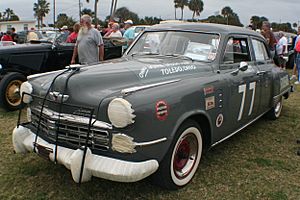
When the series began, cars were truly "stock." This meant they were production cars with almost no changes. Drivers even raced with factory seats and radios still inside! To keep the track safe, windows were rolled down, and lights were taped over. The 1957 Chevrolet "black widow" was so fast it was eventually banned by NASCAR.
Generation 2 (1965–1980)
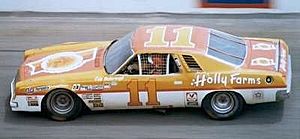
In 1965, cars started to have modified chassis. Mid-size cars like the Ford Fairlane became popular. Eventually, some cars were made specifically for NASCAR racing, like the Dodge Charger Daytona and Plymouth Superbird. These cars had special rounded noses and tall rear wings that helped them reach speeds of 200 mph (320 km/h)!
NASCAR later changed the rules to limit the engine size of these special "aero cars." This made them less competitive. In 1970, NASCAR also started using "restrictor plates" on engines to lower speeds. By 1975, the maximum engine size was set to 358 cubic inches (5.8 liters), which is still used today.
Generation 3 (1981–1991)
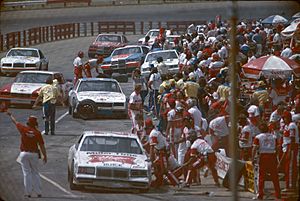
In the late 1970s, American cars became smaller. NASCAR had to adjust its rules for car size. For the 1981 season, the minimum wheelbase (distance between front and rear wheels) was reduced. Cars like the Buick Regal and Ford Thunderbird became very successful due to their aerodynamic shapes.
In 1987, Bill Elliott set a world stock-car record with a speed of 212.809 mph (342.482 km/h) at Talladega. However, during a race, Bobby Allison had a flat tire and his car crashed into the catch fence. This accident, where several spectators were injured, led to a very important safety change: NASCAR made it mandatory to use a "restrictor plate" at Talladega and Daytona. These plates help reduce speeds, making the races safer for everyone.
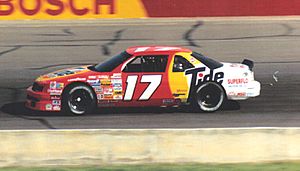
Generation 4 (1992–2007)
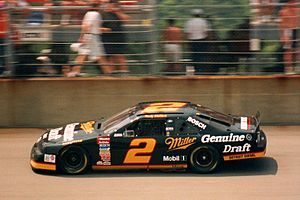
The Generation 4 car, starting in 1992, moved even further away from "stock" production cars. Steel bumpers were replaced with lighter fiberglass. In 1994, "roof flaps" were added to all cars after some crashes where cars became airborne.
While the race cars were named after production models like the Dodge Charger R/T or Ford Fusion, their similarities to street cars were mostly in the shape of the nose and tail. NASCAR eventually made rules for "common templates" in 2003. This meant all cars had to fit the same basic shape, no matter the brand, to ensure fair competition.
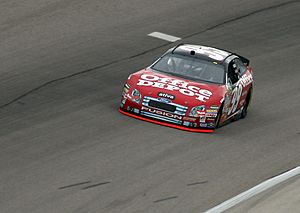
Car of Tomorrow (2007–2012)
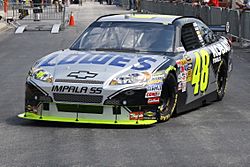
In 2007, NASCAR introduced a completely new car design called the "Car of Tomorrow" (CoT). The main goals were to control costs, make racing fairer, and improve driver safety. The car was wider and taller, and the driver's seat was moved closer to the center for safety.
One big change was a rear wing instead of the traditional spoiler. This wing could be adjusted. However, the wing was controversial, and in 2010, NASCAR decided to switch back to the original spoiler. In 2012, a major engine change happened when NASCAR started using fuel injection technology.
Generation 6 Car (2013–2021)
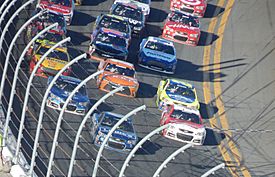
In 2013, manufacturers were given more freedom to make their NASCAR Cup Series cars look like their street versions. This created the Generation 6 race car.
All NASCAR Cup Series cars started using a digital dashboard in 2016. This dash has many customizable screens, allowing drivers to see lots of information like lap times and engine details. As sedan sales declined, pony cars like the Chevrolet Camaro (2018) and Ford Mustang (2019) returned to the Cup Series.
Next Gen Car (2022–Present)
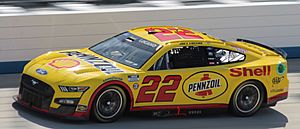
In 2022, NASCAR introduced the "Next Gen" car, the seventh generation of Cup cars. This car has improved aero and downforce features. It also brought new technologies to the track, like center lock wheels and rear diffusers, which are common in road racing. The Next Gen car aims to lower costs for teams and attract new car manufacturers to compete.
In 2023, a special Next Gen Camaro, modified by Hendrick Motorsports, even raced in the famous 2023 24 Hours of Le Mans endurance race!
Car Setup and Handling
Teams adjust a car's suspension, brakes, and aerodynamic parts to suit different racetracks. A car that tends to go straight when turning left is called "tight" or "pushing." A car that slides its back end around is called "loose" or "free." If a car is too loose, it can spin out!
Teams can change things like the front and rear downforce, spring rates, and tire pressure to fix handling problems. Tire stagger (using tires of slightly different sizes) also affects how a car handles. These settings are carefully chosen by NASCAR and Goodyear engineers.
Weather can also change how a car handles. On oval tracks, rain stops the race immediately. However, NASCAR now has rain tires for road course races, which were first used in the Cup Series in 2020 and 2021.
NASCAR Cup Tracks
The NASCAR Cup Series races are held all over the United States, mostly in eastern states. The 2024 season included 31 races on oval tracks and 5 on road courses. Oval tracks vary in length from about half a mile (0.8 km) at Martinsville Speedway to 2.66 miles (4.28 km) at Talladega Superspeedway. Most oval tracks are paved with asphalt, but some use concrete. After not racing on dirt tracks for over 50 years, dirt racing returned to the schedule in 2021 at Bristol Motor Speedway.
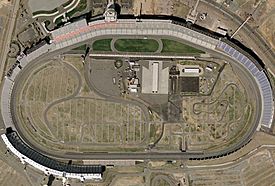
While some tracks are simple ovals, like Bristol Motor Speedway, many are "tri-ovals." Other unique tracks include Darlington Raceway with its "egg" shape, the triangular Pocono Raceway, and the rectangle of Indianapolis Motor Speedway.
NASCAR usually races counter-clockwise on ovals. However, Sonoma Raceway and Watkins Glen International are complex road courses where cars race clockwise. NASCAR has raced on road courses every year since 1963.
Tracks also have different amounts of banking (how steep the corners are). New Hampshire Motor Speedway has very flat corners (7 degrees), while Talladega Superspeedway has very steep banking (33 degrees).
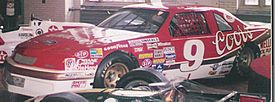
Race speeds vary a lot depending on the track. Talladega Superspeedway is the fastest, with a record average speed of 188.354 mph (303.126 km/h). The record qualifying lap there was 212.809 mph (342.482 km/h), set by Bill Elliott in 1987. This record is unlikely to be broken because "restrictor plates" (now "tapered spacers") were made mandatory in 1988 to reduce speeds and make racing safer.
The slowest tracks are road courses like Sonoma Raceway, and short ovals like Martinsville Speedway. The average speed of a race includes laps under caution but not time spent under red flags.
See also
 In Spanish: NASCAR Cup Series para niños
In Spanish: NASCAR Cup Series para niños
- List of all-time NASCAR Cup Series winners
- List of NASCAR Cup Series champions
- List of NASCAR tracks
- List of NASCAR teams
- NASCAR Xfinity Series
- NASCAR Craftsman Truck Series
- NASCAR rules and regulations



